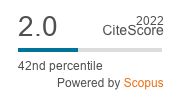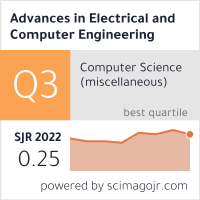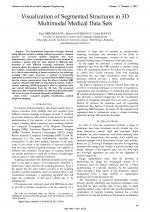| 3/2011 - 16 |
Visualization of Segmented Structures in 3D Multimodal Medical Data SetsHERGHELEGIU, P. |
| View the paper record and citations in |
| Click to see author's profile in |
| Download PDF |
Author keywords
computer graphics, visualization, medical diagnostic imaging
References keywords
image(10), visualization(8), graphics(6), rendering(5), medical(5), registration(4), multimodal(4), data(4)
Blue keywords are present in both the references section and the paper title.
About this article
Date of Publication: 2011-08-31
Volume 11, Issue 3, Year 2011, On page(s): 99 - 104
ISSN: 1582-7445, e-ISSN: 1844-7600
Digital Object Identifier: 10.4316/AECE.2011.03016
Web of Science Accession Number: 000296186700016
SCOPUS ID: 80055074089
Abstract
The simultaneous inspection of images obtained using different medical scanning methods represents a common practice for accurate medical diagnosis. The term multimodality refers to multiple medical data sets obtained by scanning a patient with the same method at different time moments or with different scanning techniques. Recent research efforts in computer graphics have attempted to solve the problem of visualizing multimodal data in the same scene, for a better understanding of human anatomy or for pathology tracking. This paper proposes a method of integrating segmented structures from a contrast enhanced MRI sequence into the volume reconstructed from the slices of another MRI sequence obtained with different scanning parameters. A direct volume rendering (DVR) approach is used to represent focus and context information from the 3D data. The presented approach aims to help physicians in understanding pathologies and in the process of accurate diagnosis establishment. |
| References | | | Cited By «-- Click to see who has cited this paper |
| [1] J. A. Bushberg, E. M. Leidholdt, J. M. Boone. The Essential Physics of Medical Imaging (2nd ed.). Lippincott Williams & Wilkins (2001).
[2] M. V. Wyawahare, P. M. Patil, H. K. Abhyankar, "Image Registration Techniques: An overview". Pattern Recognition 2, pp. 11-28 (2009). [3] D. Mattes, R. Haynor, H. Vesselle, T. K. Lewellen, W. Eubank: "Nonrigid multimodality image registration". Medical Imaging: Image Processing, SPIE 4322, pp. 1609-1620, (2001), [CrossRef] [SCOPUS Times Cited 360] [4] B. Fischer, J. Modersitzki, "Ill-posed medicine - an introduction to image registration". Inverse problems. IOP Publishing. 24-3, pp. 251-267, (2008), [CrossRef] [Web of Science Times Cited 123] [SCOPUS Times Cited 153] [5] H. Zhang, J. E. Fritts, S. A. Goldman, "Image segmentation evaluation: A survey of unsupervised methods". Computer Vision and Image Understanding, vol. 110, pp. 260-280, (2008), [CrossRef] [Web of Science Times Cited 609] [SCOPUS Times Cited 841] [6] N. Passat, C Ronse, J Baruthio, J.-P. Armspach, J. Foucher, "Watershed and multimodalnext term data for brain vessel segmentation: Application to the superior sagittal sinus". Image and Vision Computing Volume 25(4), pp 512-521, (2007), [CrossRef] [Web of Science Times Cited 18] [SCOPUS Times Cited 20] [7] J. Beyer, M. Hadwiger, S. Wolfsberger, K. Bühler. "High-quality multimodal volume rendering for preoperative planning of neurosurgical interventions". IEEE Transactions on Visualization and Computer Graphics (Proceedings of IEEE Visualization 2007), vol 13(6), pp 1696-1703, (2007), [CrossRef] [Web of Science Times Cited 63] [SCOPUS Times Cited 92] [8] M. Levoy, "Display of surfaces from volume data". In IEEE Computer Graphics and Applications, vol 8, pp 29-37, (1988), Available: http://dx.doi.org/10.1109/38.511. [9] M. Hadwiger, J. Kniss, C. Rezk-Salama, D. Weiskopf, and K. Engel. Real-time Volume Graphics. Wellesley, MA: AK Peters, (2006) [10] A. Ghosh, P. Prabhu, A.E. Kaufman, K. Mueller. "Hardware assisted multichannel volume rendering". In Proceedings of Computer Graphics International 2003, pp. 2-7, (2003), [CrossRef] [Web of Science Times Cited 14] [SCOPUS Times Cited 15] [11] H. Nguyen. GPU Gems 3. Addison-Wesley, (2008) [12] F. Rosler, E. Tejada, T. Fangmeier, T. Ertl, and M. Knauff, "GPU-based multi-volume rendering for the visualization of functional brain images". In Proceedings of SimVis 2006, pp 305-318, (2006) [13] I.H. Manssour, S. S. Furuie, S. D. Olabarriaga, C.M.D.S. Freitas, "Visualizing inner structures in multimodal volume data". In Proceedings of SIBGRAPI 2002, pp. 51-58, (2002), [CrossRef] [Web of Science Times Cited 7] [SCOPUS Times Cited 12] [14] M. Burns, M. Haidacher, W. Wein, I. Viola, E. Gröller. "Feature Emphasis and Contextual Cutaways for Multimodal Medical Visualization". In Proceedings of EuroVis'2007, pp.275-282, (2007), [CrossRef] [15] D. T. Gering, A. Nabavi, R. Kikinis, W. E. L. Grimson, N. Hata, P. Everett, F. A. Jolesz, W. M. Wells 3rd. "An integrated visualization system for surgical planning and guidance using image fusion and interventional imaging". In Medical Image Computing and Computer Assisted Intervention-MICCAI'99, pp. 809-819, (1999). [16] J. Ahrens, B. Geveci, C. Law, "An End-User Tool for Large-Data Visualization". In Visualization Handbook Edited by C.D. Hansen and C.R. Johnson, pp 717-731 (2005). [CrossRef] [SCOPUS Times Cited 1232] [17] J. Meyer-Spradow, T. Ropinski, J. Mensmann, K. Hinrichs, "Voreen: A Rapid-Prototyping Environment for Ray-Casting-Based Volume Visualizations". In IEEE Computer Graphics and Applications, vol. 29(6), pp. 6-13, (2009), [CrossRef] [Web of Science Times Cited 104] [SCOPUS Times Cited 136] [18] M. A. Brown, R. C. Semelka. MRI: Basic Principles and Applications, John Wiley and Sons, (2010). [19] L. Ibanez, W. Schroeder, L. Ng, J. Cates. The ITK Software Guide. Kitware, (2005). [20] D. L. G. Hill, P. G. Batchelor, M. Holden, D. J. Hawkes, "Medical image registration". Physics in medicine and biology (IOP), vol. 46(3), R1-R45, (2001), [CrossRef] [Web of Science Times Cited 1022] [SCOPUS Times Cited 1215] [21] F. Meyer, "Topographic distance and watershed lines", Signal Processing, vol. 38(1), pp. 113-125, (1994), [CrossRef] [Web of Science Times Cited 957] [SCOPUS Times Cited 1125] [22] H. Ray, H. Pfister, D. Silver, T. A. Cook, "Ray casting architectures for volume visualization", IEEE Trans. Vis. Comput. Gr., vol. 5(3), pp. 210-223, (1999), [CrossRef] [Web of Science Times Cited 45] [SCOPUS Times Cited 64] [23] J. Kniss, G. Kindlmann, C. Hansen, "Multidimensional transfer functions for interactive volume rendering", IEEE Trans. Vis. Comput. Gr., vol. 8(3), pp. 270-285, (2002), [CrossRef] [Web of Science Times Cited 339] [SCOPUS Times Cited 464] [24] J. Hladuvka, A. H. König, E. Groller, "Curvature-based transfer functions for direct volume rendering". In Proceedings of the Spring Conference on Computer Graphics 2000, pp 58-65, (2000). Web of Science® Citations for all references: 3,301 TCR SCOPUS® Citations for all references: 5,729 TCR Web of Science® Average Citations per reference: 138 ACR SCOPUS® Average Citations per reference: 239 ACR TCR = Total Citations for References / ACR = Average Citations per Reference We introduced in 2010 - for the first time in scientific publishing, the term "References Weight", as a quantitative indication of the quality ... Read more Citations for references updated on 2024-04-19 17:47 in 86 seconds. Note1: Web of Science® is a registered trademark of Clarivate Analytics. Note2: SCOPUS® is a registered trademark of Elsevier B.V. Disclaimer: All queries to the respective databases were made by using the DOI record of every reference (where available). Due to technical problems beyond our control, the information is not always accurate. Please use the CrossRef link to visit the respective publisher site. |
Faculty of Electrical Engineering and Computer Science
Stefan cel Mare University of Suceava, Romania
All rights reserved: Advances in Electrical and Computer Engineering is a registered trademark of the Stefan cel Mare University of Suceava. No part of this publication may be reproduced, stored in a retrieval system, photocopied, recorded or archived, without the written permission from the Editor. When authors submit their papers for publication, they agree that the copyright for their article be transferred to the Faculty of Electrical Engineering and Computer Science, Stefan cel Mare University of Suceava, Romania, if and only if the articles are accepted for publication. The copyright covers the exclusive rights to reproduce and distribute the article, including reprints and translations.
Permission for other use: The copyright owner's consent does not extend to copying for general distribution, for promotion, for creating new works, or for resale. Specific written permission must be obtained from the Editor for such copying. Direct linking to files hosted on this website is strictly prohibited.
Disclaimer: Whilst every effort is made by the publishers and editorial board to see that no inaccurate or misleading data, opinions or statements appear in this journal, they wish to make it clear that all information and opinions formulated in the articles, as well as linguistic accuracy, are the sole responsibility of the author.





